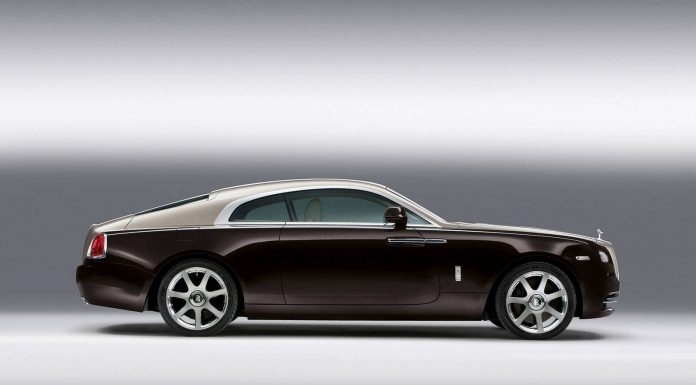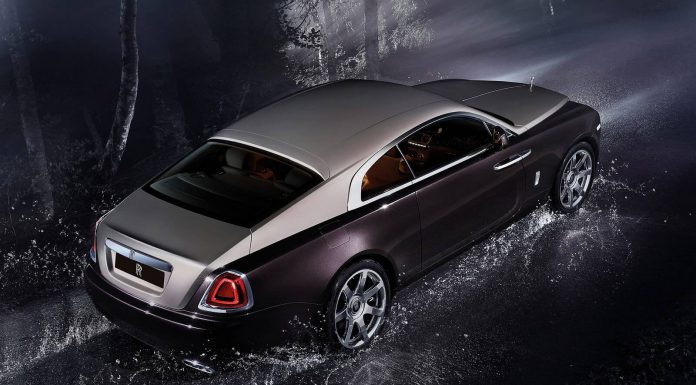Rolls-Royce released the much anticipated Rolls-Royce Wraith today. It will debut at the Geneva Motor Show 2013 as the most powerful and fastest Rolls-Royce model to date. The release revives a name that the British company has not used since 1939. Back then, the car was sold as a chassis to be bodied externally. Today, customers will be able to order the complete car.
The Rolls-Royce Wraith has been designed as a luxurious, refined and exclusive Grand Tourer. It is a fastback design, as many have expected. The Wraith gets typical Rolls-Royce traits including a two-tone paint scheme and a modern Rolls-Royce grille.
The Rolls-Royce Wraith is built using traditional methods. Instead of a modern aluminium body, the Wraith uses a steel monocoque body. The advantages are simple. First, it means that the body panels and the chassis are one and the same. It gets a double front bulkhead the insulate from engine and road noise. In total, 6,364 individual spot-welds are applied to Wraith with 900m laser welded seams.
Compared with Rolls-Royce Ghost, the rear axle is 24 mm wider, the wheelbase is 183 mm shorter and the centre of gravity nearer the road thanks to a reduction in height of 5 cm. Rolls-Royce have set the Wraith to minimise body roll, with light steering at low speeds and heavier steering at high speeds. The Wraith gets double-wishbone front suspension and multi-link rear suspension with electronic variable damping and air suspension.
Individual load calculations are made by the dampers every 2.5 milliseconds which makes the Rolls-Royce Wraith one of the most comfortable Rolls-Royce models currently available. Electronic driver assistance for the Wraith include anti-roll stabilisation, dynamic stability control, including dynamic traction control together with cornering brake control and dynamic brake control.
The Rolls-Royce Wraith develops 624bhp and 800Nm of torque from a 6.6 litre twin-turbo V12 with direct petrol injection. This makes it the most powerful Rolls-Royce ever! This means the Wraith will hit 62mph in just 4.6 seconds and go on to an electronically governed top speed of 155mph. The power is routed through an eight speed, automatic ZF transmission to the rear wheels.
The accelerator pedal is fitted with a feature that Rolls-Royce refer to as “multi-shift”. A sensor in the accelerator recognises when the driver is fully depressing the pedal. It then moves down a few gears for optimum performance. The gearbox also makes use of a feature called “Satellite Aided Transmission” which uses GPS to determine the driver’s next moves and plan for them accordingly.
The interior is as you would expect from a Rolls-Royce. It is available to cusomise like any other Rolls-Royce. The doors feature woodern Canadel Panelling and the dials get blood orange needle tips for speedometer and power reserve gauge. For the first time outside of the Rolls-Royce Phantom range, a Starlight headliner is offered.
The Wraith features many connectivity features too. A button on the steering wheel allows navigation, telephone and other commands to be directed straight into the on board computer. This is displayed through a 10.25 inch High Definition screen mounted on the dashboard. Real Time Traffic Information is built into the on board Satellite Navigation. Through the free Rolls-Royce Connect App, a driver can send postcodes to his car.
The controller for the system, called the Spirit of Ecstasy Rotary Controller, is now a touch pad with all the simplicity you would expect. The Wraith’s on-board hard drive holds 20.5 GB of storage coupled with a 1,300 watt, 18-channel speaker system. Speakers include central bass speakers located in the boot, seven tweeters, seven mid-range and two ‘exciter’ speakers in the headliner bringing the sound sensation to ear level.
The Rolls-Royce Wraith really is the full package. Worth of the name, we can’t wait to see it tomorrow on the Geneva Motor Show 2013 show floor!



































